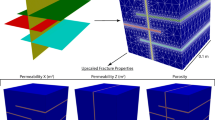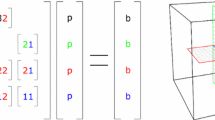Abstract
Simulating the deformation of fractured media requires the coupling of different models for the deformation of fractures and the formation surrounding them. We consider a cell-centered finite-volume approach, termed the multi-point stress approximation (MPSA) method, which is developed in order to discretize coupled flow and mechanical deformation in the subsurface. Within the MPSA framework, we consider fractures as co-dimension one inclusions in the domain, with the fracture surfaces represented as line pairs in 2D (face pairs in 3D) that displace relative to each other. Fracture deformation is coupled to that of the surrounding domain through internal boundary conditions. This approach is natural within the finite-volume framework, where tractions are defined on surfaces of the grid. The MPSA method is capable of modeling deformation, considering open and closed fractures with complex and nonlinear relationships governing the displacements and tractions at the fracture surfaces. We validate our proposed approach using both problems, for which analytical solutions are available, and more complex benchmark problems, including comparison with a finite-element discretization.
Similar content being viewed by others
References
Jaeger, J.C., Cook, N.G., Zimmerman, R.: Fundamentals of Rock Mechanics. Wiley, New York (2009)
Jing, L.: A review of techniques, advances and outstanding issues in numerical modelling for rock mechanics and rock engineering. Int. J. Rock Mech. Min. 40(3), 283–353 (2003). https://doi.org/10.1016/s1365-1609(03)00013-3
McClure, M.W., Horne, R.N.: An investigation of stimulation mechanisms in enhanced geothermal systems. Int. J. Rock Mech. Min 72, 242–260 (2014). https://doi.org/10.1016/j.ijrmms.2014.07.011
Oldenburg, C., Pruess, K., Benson, S.M.: Process modeling of CO2 injection into natural gas reservoirs for carbon sequestration and enhanced gas recovery. Energ. Fuel 15(2), 293–298 (2001)
Rutqvist, J.: Status of the TOUGH-FLAC simulator and recent applications related to coupled fluid flow and crustal deformations. Comput. Geosci 37(6), 739–750 (2011). https://doi.org/10.1016/j.cageo.2010.08.006
Rutqvist, J., Stephansson, O.: The role of hydromechanical coupling in fractured rock engineering. Hydrogeol. J. 11(1), 7–40 (2003). https://doi.org/10.1007/s10040-002-0241-5
Anderson, T.L.: Fracture Mechanics: Fundamentals and Applications. CRC, Boca Raton (2005)
Adachi, J., Siebrits, E., Peirce, A., Desroches, J.: Computer simulation of hydraulic fractures. Int. J. Rock Mech. Min. 44(5), 739–757 (2007). https://doi.org/10.1016/j.ijrmms.2006.11.006
Liu, Y.J., Mukherjee, S., Nishimura, N., Schanz, M., Ye, W., Sutradhar, A., Pan, E., Dumont, N.A., Frangi, A., Saez, A.: Recent advances and emerging applications of the boundary element method. Appl. Mech. Rev. 64(3), 030802 (2012). https://doi.org/10.1115/1.4005491
McClure, M.W., Horne, R.N.: Investigation of injection-induced seismicity using a coupled fluid flow and rate/state friction model. Geophysics 76(6), WC181–WC198 (2011). https://doi.org/10.1190/geo2011-0064.1
Norbeck, J.H., McClure, M.W., Lo, J.W., Horne, R.N.: An embedded fracture modeling framework for simulation of hydraulic fracturing and shear stimulation. Computat. Geosci. 20(1), 1–18 (2016). https://doi.org/10.1007/s10596-015-9543-2
Crouch, S.L., Starfield, A.: Boundary Element Methods in Solid Mechanics: With Applications in Rock Mechanics and Geological Engineering. Allen & Unwin, London (1982)
Shou, K., Crouch, S.: A higher order displacement discontinuity method for analysis of crack problems. Int. J. Rock Mech. Min. Sci. & Geomech. Abstr. 1, 49–55 (1995)
Zhou, X., Ghassemi, A.: Three-dimensional poroelastic analysis of a pressurized natural fracture. Int. J. Rock Mech. Min. 48(4), 527–534 (2011). https://doi.org/10.1016/j.ijrmms.2011.02.002
Borja, R.I.: Plasticity. Springer, Berlin (2013)
Aagaard, B.T., Knepley, M.G., Williams, C.A.: A domain decomposition approach to implementing fault slip in finite-element models of quasi-static and dynamic crustal deformation. J. Geophys. Res. Solid Earth 118(6), 3059–3079 (2013). https://doi.org/10.1002/jgrb.50217
Kuna, M.: Finite elements in fracture mechanics. Springer, Berlin (2013)
Garipov, T.T., Karimi-Fard, M., Tchelepi, H.A.: Discrete fracture model for coupled flow and geomechanics. Computat. Geosci. 20(1), 149–160 (2016). https://doi.org/10.1007/s10596-015-9554-z
Kim, J., Tchelepi, H.A., Juanes, R.: Stability and convergence of sequential methods for coupled flow and geomechanics: fixed-stress and fixed-strain splits. Comput. Method Appl. M 200(13–16), 1591–1606 (2011). https://doi.org/10.1016/j.cma.2010.12.022
Kim, J., Tchelepi, H.A., Juanes, R.: Stability, accuracy and efficiency of sequential methods for coupled flow and geomechanics. In: SPE Reservoir Simulation Symposium. Society of Petroleum Engineers (2009)
Castelletto, N., White, J.A., Tchelepi, H.A.: Accuracy and convergence properties of the fixed-stress iterative solution of two-way coupled poromechanics. Int. J. Numer. Anal. Methods 39(14), 1593–1618 (2015). https://doi.org/10.1002/nag.2400
Nordbotten, J.M.: Cell-centered finite volume discretizations for deformable porous media. Int. J. Numer. Methods Eng. 100(6), 399–418 (2014). https://doi.org/10.1002/nme.4734
Aavatsmark, I.: An introduction to multipoint flux approximations for quadrilateral grids. Comput. Geosci. 6(3), 405–432 (2002)
Keilegavlen, E., Nordbotten, J.M.: Finite volume methods for elasticity with weak symmetry. Int. J. Numer. Methods Eng. 112(8), 939–962 (2017). https://doi.org/10.1002/nme.5538
Nordbotten, J.M.: Convergence of a cell-centered finite volume discretization for linear elasticity. SIAM J. Numer. Anal. 53(6), 2605–2625 (2015). https://doi.org/10.1137/140972792
Nordbotten, J.M.: Stable cell-centered finite volume discretization for Biot equations. SIAM J. Numer. Anal. 54(2), 942–968 (2016). https://doi.org/10.1137/15m1014280
Ucar, E., Keilegavlen, E., Berre, I.: Post-injection normal closure of fractures as a mechanism for induced seismicity. Geophys. Res. Lett. 44, 9598–9606 (2017). https://doi.org/10.1002/2017GL074282
Andrews, D.: Test of two methods for faulting in finite-difference calculations. Bull. Seismol. Soc. Am. 89(4), 931–937 (1999)
Daub, E.G., Carlson, J.M.: Friction, fracture, and earthquakes. Annu. Rev. Condens. Matter Phys. 1(1), 397–418 (2010)
Ida, Y.: Cohesive force across the tip of a longitudinal-shear crack and Griffith’s specific surface energy. J. Geophys. Res. 77(20), 3796–3805 (1972)
Andrews, D.: Rupture models with dynamically determined breakdown displacement. Bull. Seismol. Soc. Am. 94(3), 769–775 (2004)
Dieterich, J.H.: Modeling of rock friction: 1. Experimental results and constitutive equations. J. Geophys. Res. 84(B5), 2161 (1979). https://doi.org/10.1029/JB084iB05p02161
Kelley, C.T.: Solving Nonlinear Equations with Newton’s Method, vol. 1. SIAM, Philadelphia (2003)
Shewchuck, J.: Engineering a 2D quality mesh generator and Delaunay triangulator. In: Lin MC, Manocha D (eds.) Applied computational geometry: towards geometric engineering. Lecture notes in computer science, vol. 1148. From the First ACM Workshop on Applied Computational Geometry, pp 203–222. Springer, New York (1996)
Zehnder, A.T.: Fracture mechanics. (Lecture notes in applied and computational mechanics, vol. 62). Springer, Netherlands (2012)
Lawn, B.: Fracture of Brittle Solids. Cambridge University Press, Cambridge (1993)
Dugdale, D.S.: Yielding of steel sheets containing slits. J. Mech. Phys. Solids 8(2), 100–104 (1960)
Sneddon, I.N.: Fourier Transforms. McGraw Hill Book Co, Inc., New York (1951)
Phan, A.V., Napier, J.A.L., Gray, L.J., Kaplan, T.: Symmetric-Galerkin BEM simulation of fracture with frictional contact. Int. J. Numer. Methods Eng. 57(6), 835–851 (2003). https://doi.org/10.1002/nme.707
Lie, K.A.: An introduction to reservoir simulation using MATLAB user guide for the MATLAB reservoir simulation toolbox (MRST). SINTEF ICT, Department of Applied Mathematics (2014)
Aagaard, B., Knepley, M., Williams, C., Strand, L., Kientz, S.: PyLith user manual, version 2.1.0. Computational Infrastructure for Geodynamics (CIG), University of California, Davis (2015)
Acknowledgements
The work was funded by the Research Council of Norway through grants no. 228832/E20, 267908/E20 and 250223 and Statoil ASA through the Akademia agreement.
Author information
Authors and Affiliations
Corresponding author
Appendix
Appendix
The analytical solutions of the induced displacements (ux, uy) and stresses (σxx, σyy, σxy) at any point (x,y) for an infinite 2D homogeneous and isotropic elastic nonporous medium containing a finite small thin fracture with constant normal- and shear-displacement discontinuities are given by Crouch and Starfield [12] as
and
where \({{\Delta } u}_{\boldsymbol {n}_{+}}^{{{\Gamma }} }\) and \({{\Delta } u}_{\boldsymbol {\tau }_{+}}^{{{\Gamma }} }\) are the displacement discontinuities in the normal and shear directions, respectively; μ is the shear modulus; v is Poisson’s ratio; and f is the function of the position (x,y) of the field point relative to the center of the fracture. Denoting the half radius of the fracture as a, f is given as
Rights and permissions
About this article
Cite this article
Ucar, E., Keilegavlen, E., Berre, I. et al. A finite-volume discretization for deformation of fractured media. Comput Geosci 22, 993–1007 (2018). https://doi.org/10.1007/s10596-018-9734-8
Received:
Accepted:
Published:
Issue Date:
DOI: https://doi.org/10.1007/s10596-018-9734-8




